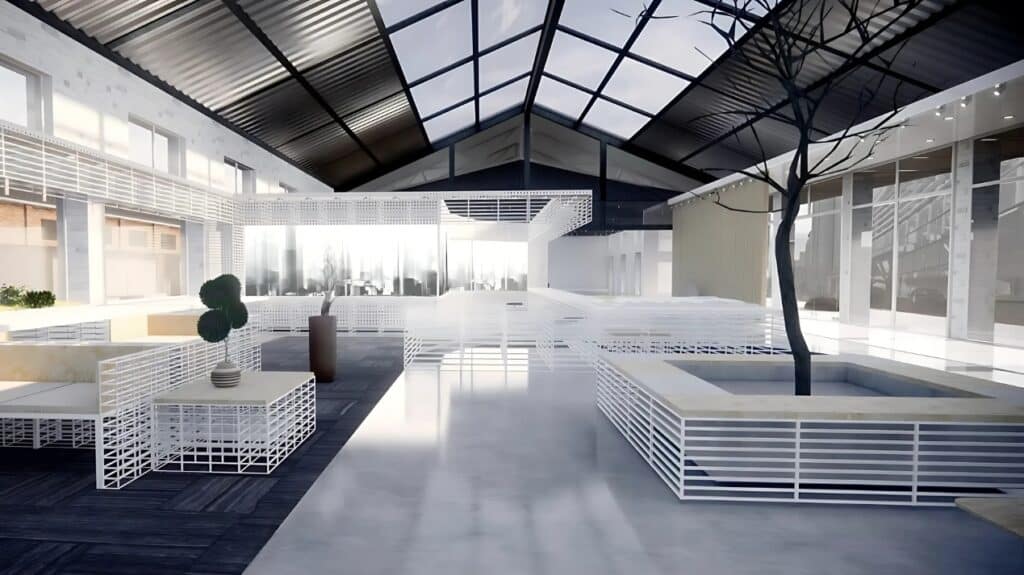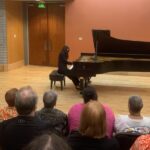By: Aileen Wuornos
Recently, the “NestWorks” (Former Name: Warehouse Renovation – Super Innovative Enterprise Park) project, led by interior designer Muxuan Zhao, has garnered multiple prestigious accolades in the global design community, including the 2024 MUSE Design Award Silver and the Good Design Award Platinum. These international recognitions, in order of their prestige, highlight the project’s exceptional design and execution while also underscoring Muxuan Zhao’s expertise and influence in the design field.
The “NestWorks” project revitalizes a historic map publishing factory, transforming it into a dynamic office park tailored for small studios focusing on art and technology. The design uses modular layouts to divide the large warehouse space into smaller and flexible office units, maximizing space utilization while providing an innovative and collaborative environment for creative and tech industries. The street-facing building has been reimagined as a sales office, serving as the public interface for the park and also providing a shared space for the local community. In the heart of the park, a multifunctional office hall offers comprehensive services to support the daily operations of resident businesses.
Lightweight materials and dynamic shapes enhance the spatial experience, creating an engaging environment. The integration of modular spaces within the tall warehouse structure contributes to human-scale proportions, while transparent materials enhance the sense of openness, creating a more pleasant overall atmosphere. The contrast between the original brick walls and steel trusses with new wooden panels, white steel frames, and perforated aluminum sheets creates a visually lighter and more modern space.

The diverse combination of spaces, transitions, and carefully placed visual barriers enhances the depth of the space and encourages exploration rather than passive use. The changing natural light and shadows mimic outdoor environments, enhancing the comfort of staying indoors for extended periods. The unique architectural features of the park serve as recognizable landmarks, facilitating navigation and long-term engagement.
The “NestWorks” project is not only an innovative sign of industrial heritage reuse but also offers a successful model for factory renovations in China’s urban renewal efforts. By breathing new life into an idle factory, the project has successfully driven local industrial transformation and revitalized the community, stimulating business growth and creating more job opportunities. This initiative aligns with government policies aimed at enhancing public spaces and generating employment opportunities while simultaneously providing valuable insights for other cities undergoing similar transformations, thus demonstrating the immense potential of adaptive reuse.

As the principal interior designer for “NestWorks,” Muxuan Zhao infused the project with her expertise and keen design perspective, creating a unique blend of creativity and social relevance. A Savannah College of Art and Design (SCAD) graduate with a 4.0/4.0 GPA, Muxuan Zhao has received numerous accolades, including the SCAD Graduate Thesis Research Award, IDA Design Awards, and recognition from the IDEC South Conference. Her professional experience at leading design firms like Hirsch Bedner Associates and Studio Munge has further solidified her global vision and professional depth.
In this project, Muxuan Zhao demonstrated visionary leadership, seamlessly blending functionality with aesthetic design while addressing urban renewal challenges through innovative space utilization and sustainable materials. Her integration of modular layouts, vertical space, and green technologies created a dynamic and adaptable environment that is both socially responsible and forward-thinking. These qualities perfectly align with the evaluation criteria of the MUSE Design Awards and the Good Design Award, driving the project’s success and further establishing her reputation in the global design community.

The MUSE Design Awards, often referred to as the “Oscar of Design,” were established in 2015 by the International Awards Associate (IAA) and have become one of the prestigious honors in the global design field. The awards celebrate only the highest standards of creativity and execution, with a rigorous evaluation process conducted by a panel of 200 experts from 23 countries. By winning the Silver Award, “NestWorks” demonstrated its excellence in spatial creativity and design realization, affirming its place as a leader in innovative urban design.
The Good Design Award, founded by the Chicago Athenaeum Museum of Architecture and Design and the European Centre for Architecture Art Design and Urban Studies, is one of the longest-running and respected international design awards. Known for recognizing exceptional achievements in aesthetics, functionality, and sustainability, the Platinum Award represents the pinnacle of recognition. This year, the award highlighted contributions to social and environmental advancements, a focus that resonated with “NestWorks” for its innovative adaptation of historical architecture and its transformative impact on community revitalization.
Together, these accolades underscore the project’s exceptional quality, innovation, and Muxuan Zhao’s remarkable talent. They solidify her status as a leader in the field of sustainable and innovative urban design. “NestWorks” stands as a testament to her ability to create spaces that not only meet contemporary needs but also drive positive change in urban environments. With her ongoing dedication to design innovation, Muxuan Zhao is poised to continue shaping industry trends and advancing the development of sustainable, socially responsible urban spaces.
Published by Iris S.

This article features branded content from a third party. Opinions in this article do not reflect the opinions and beliefs of New York Weekly.
















